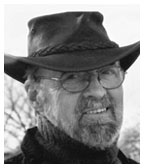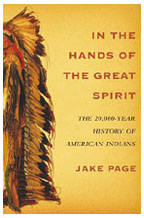July 2, 2003: Reading Room
 From
the Bering Strait to casinos
From
the Bering Strait to casinos
Jake Page ’58 explores the history of American Indians
By J. I. Merritt ’66
Photo: Most of Jake Page ’58’s 18 books deal with Indians or the Southwest. (susanne page)
Jake Page ’58 has written a sweeping history of the continent’s first inhabitants and their descendants from the Ice Age to the present. Published by Free Press, In the Hands of the Great Spirit: The 20,000-Year History of American Indians begins with the migration of Asian hunter-gatherers across the Bering land bridge and ends with 21st-century legal battles over casinos and access to sacred sites. In between is a story of conquest, disease, and all too often, cultural and physical annihilation. Page cites estimates that more than 200 tribes have become extinct since the arrival of Columbus, while the total population of American Indians plummeted from an estimated 2 million or more in 1492 to 250,000 by the early 1900s. Although their numbers once again approach precontact levels, Indians today make up less than 1 percent of the U.S. population.
 For
sources Page relies not only on the written record since 1492 but also
on archaeological findings and tribal oral histories and myths. He points
out that most of the devastation wreaked by smallpox and other Old World
diseases was indirect, spreading from one tribe to another during a period
he calls “proto-history” — after Europeans arrived but
before most Indians encountered them. “Most of them were farmers
living in villages,” he says. “Overnight, disease wiped out
all the great mound-building cultures in the South and Midwest. By the
time Europeans actually met what was left of these people they were still
reeling and in the process of reinventing themselves.”
For
sources Page relies not only on the written record since 1492 but also
on archaeological findings and tribal oral histories and myths. He points
out that most of the devastation wreaked by smallpox and other Old World
diseases was indirect, spreading from one tribe to another during a period
he calls “proto-history” — after Europeans arrived but
before most Indians encountered them. “Most of them were farmers
living in villages,” he says. “Overnight, disease wiped out
all the great mound-building cultures in the South and Midwest. By the
time Europeans actually met what was left of these people they were still
reeling and in the process of reinventing themselves.”
Page’s story includes the usual cast of characters, from Pocahontas to Sitting Bull, but also modern-day Indian activists like Russell Means and little-known whites who have championed Native-American causes, among them attorney Tom Tureen ’66, who in the 1970s won a landmark decision that forced the federal government to pay Maine’s Passamaquoddies millions of dollars for lands taken from them in the 18th century.
Page and his wife, photographer Susanne Page, live in Corrales, New Mexico, and have collaborated on two earlier books, about the Hopis and Navajos. An English major at Princeton, Page wrote his senior thesis on Henry David Thoreau and Henry Adams, and later worked as a science editor at Natural History and Smithsonian magazines. Most of the 18 books (including 10 novels) he has written, cowritten, or edited deal with Indians or the Southwest.
Indians, he says, are “struggling to retain their languages and traditions while integrating into the larger economy and culture. “I have a Navajo friend who compares his culture to a tree with a central core. If you look at the growth rings you’ll see that over many years there have been good periods and bad. The challenge is retaining your core values while incorporating stuff from the wider culture that helps you, and rejecting the stuff that is bad.”
J. I. Merritt ’66 is a former PAW editor.
BOOK SHORTS
 The Free Speech
Movement: Reflections on Berkeley in the 1960s — edited by Robert
Cohen and Reginald E. Zelnik ’56 (California). A collection of scholarly
articles and personal memoirs by participants and close observers of Berkeley’s
Free Speech Movement of 1964, the first of the major student rebellions
of the 1960s. Zelnik is a history professor at the University of California—Berkeley.
The Free Speech
Movement: Reflections on Berkeley in the 1960s — edited by Robert
Cohen and Reginald E. Zelnik ’56 (California). A collection of scholarly
articles and personal memoirs by participants and close observers of Berkeley’s
Free Speech Movement of 1964, the first of the major student rebellions
of the 1960s. Zelnik is a history professor at the University of California—Berkeley.
 Nothing
Sacred: The Truth About Judaism — Douglas Rushkoff ’83 (Crown).
The author argues that contemporary American Jewish practice is stolid
and aimed at preserving a dwindling population. Rushkoff identifies the
religion’s strengths as its emphasis on social justice and freedom
of inquiry, and he calls on a return to its dialectic roots. Rushkoff
is a professor of communications at New York University. Nothing Sacred
is his first book on religion. For
an interview with Rushkoff, click here.
Nothing
Sacred: The Truth About Judaism — Douglas Rushkoff ’83 (Crown).
The author argues that contemporary American Jewish practice is stolid
and aimed at preserving a dwindling population. Rushkoff identifies the
religion’s strengths as its emphasis on social justice and freedom
of inquiry, and he calls on a return to its dialectic roots. Rushkoff
is a professor of communications at New York University. Nothing Sacred
is his first book on religion. For
an interview with Rushkoff, click here.
 Europe in the High
Middle Ages — William Chester Jordan *73 (Viking). This history
covers the era of Gothic architecture and the Crusades, during which Dante
and Thomas Aquinas flourished, and in which the modern European nation-state
began to emerge. Among other topics, Jordan looks at peasant life and
the effects of the plague in 14th-century Europe. Jordan is director of
Princeton’s Program in Medieval Studies. For
a story on Jordan, click here.
Europe in the High
Middle Ages — William Chester Jordan *73 (Viking). This history
covers the era of Gothic architecture and the Crusades, during which Dante
and Thomas Aquinas flourished, and in which the modern European nation-state
began to emerge. Among other topics, Jordan looks at peasant life and
the effects of the plague in 14th-century Europe. Jordan is director of
Princeton’s Program in Medieval Studies. For
a story on Jordan, click here.
